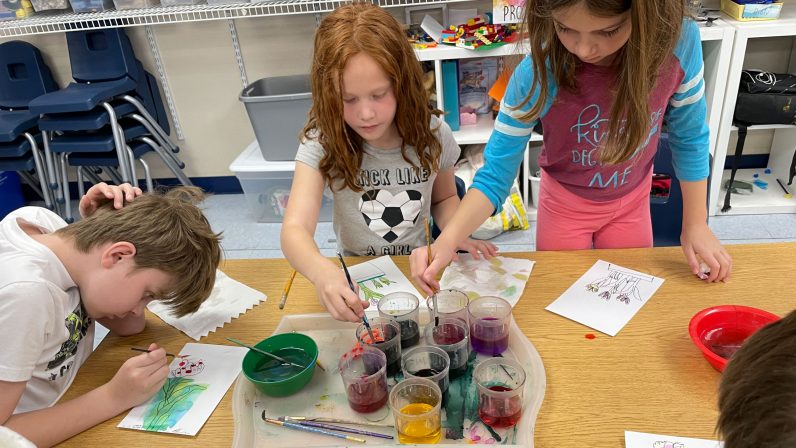We still have two months till the end of the school year, and already it feels like we’re in motion toward that ending. Lately I’ve witnessed multiple examples of growth toward mastery of skills practiced for, in some cases, years. Snippets of paper with invented spelling that a year ago was unreadable, now hold words that more closely resemble conventional spelling. Handwriting has improved and messages are clearer.
Classes are busy creating art work for the upcoming Seed 2022-2023 yearbook. One class this week drew and watercolored tulips, a symbol of their successful garden. At the beginning of the year for a project like this, considerable coaching was required to make drawings large enough, to add details, and take the risk of painting with a medium that can often be frustrating because it’s difficult to control. Simply following directions was a challenge. The group of artists painting tulips they’d drawn was an entirely different experience. Children who tended to be distracted demonstrated intentional focus. They applied techniques and suggestions made during the preliminary mini-lesson. Children who historically hurried through their work for the sake of being done took their time and used surprising details without prompting. The collection of tulip paintings is an example of wonderful growth, both in the garden and the classroom.
Another example of progress is with the 1st-4th grade writers. Each child in our two oldest classes is in the process of completing a published book. First and second graders are working on personal narratives, writing about topics such as playing with dolls, trips to the ice cream store, a favorite pet, or their own art room at home. Some of these children at the beginning of the year could barely write a few words, let alone put together a story. At this time of year, most of them have become independent writers who can choose their own topics, map out their story, and write at least a minimal draft. Participating in helping each child, one by one, to publish and bind their story is quite remarkable.
The progress of one writer in particular has captured my heart this week. The third and fourth graders have taken on the challenge of writing a fictional story that has to include a real life problem. It’s been a growth experience for many of these writers as they blend their creativity together with the believability of a real life problem. One writer, with whom I’ve worked since he was in first grade, has shown immense growth. We sat together this week to add final touches to his story before publishing. As the editor, I had a few suggestions, including order of providing certain information, naming the characters (instead of referring to them as the tarantula hawk and tarantula), and making sure the whole story was written in the same tense. Adjusting the tense was an easy change, as was the idea of switching text on the last two pages. Naming the characters was a different story, although once there was agreement to do so, it was evident it brought excellent clarity to the story. As I watched this student begin illustrating his remarkable story, I remembered the same child three years ago as a beginning writer working on a piece comparing different water slides in Seattle. I’m honored to have been a part of this child’s progress, as well as that of his classmates. Launching more writers’ voices into the world seems like important work in these times.

